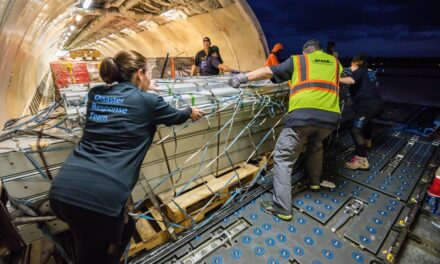
USPS carbon accounting pilot could lead to offset service
The US Postal Service is to pilot a new carbon accounting system from next month, which could pave the way for a full carbon offsets program to counter the environmental impacts of shipping services. The pilot is scheduled to begin implementation in June, and will initially be available for business customers using the Electronic Verification System (eVS). It would allow them to calculate carbon emissions for packages for carbon accounting and corporate social responsibility reporting.
Free of charge, the service will take the form of an online calculator and reporting function within the eVS system.
The Postal Service told Post&Parcel that once the system is successfully in place for packages, it could then be expanded to cover mail products.
“We are very excited about this. It will be a free service and we want to use it as a way to provide additional value for our shipping services,” said chief sustainability officer Emil Dzuray.
Dzuray told Post&Parcel that a second phase of the carbon accounting program would hopefully see the Postal Service offering an offsetting program in which its customers could purchase verified offsets through USPS.
“We would hope to see offsets early in the calendar year 2012,” he said.
“It would be a premium offering, but if you are going to offset, you might as well do it through the Postal Service. And where trust is a key part of this kind of offset program, our offsets will meet all the standard certifications – domestic offset projects, not international, in public settings.”
Sustainability
While offering an offsetting program would bring USPS more in line with some of its rivals, it would also tend to spur on the effort of the Postal Service to continually improve the carbon footprint of its shipping services. Customers are already pushing for the USPS to improve its sustainability, as is the US Congress.
And, Dzuray said the financially-constrained USPS has already been improving its environmental credentials through a “conservation culture”, based on projects that provide good returns on initial investment. So far, it has reduced its greenhouse gas emissions by about 8% compared to a 2003 baseline, while energy consumption of buildings has been cut by 28%, meaning a target of 30% by 2015 is well within reach.
Although the Postal Service is not mandated to reach sustainability targets, it is working on 15 different sustainability goals and aims to outperform industry averages.
“We are being very diligent in how we are spending money: our focus now is on low-cost and no-cost environmental activities because we are capital-constrained,” Dzuray said. “This means we’re not spending money on new vehicles, although that is something for the future. It means mainly local process changes that can have an enormous benefit.”
Measures being taken forward include mail processing system improvements, replacement of inefficient heating and lighting systems in USPS buildings, upgrading of building insulation and windows to be more energy-efficient, as well as “aggressively” pursuing opportunities to recycle waste across the network.
However, the lack of capital means projects like the development of renewable energy supplies will have to wait until technology costs come down, Dzuray said, although the Postal Service does have two megawatts of solar capacity in California as well as new fuel cell co-generation system in San Diego.
Postal Service renewable energy ambitions have also been unable to benefit from federal tax credits in recent years, because the Postal Service does not pay taxes in order to claim back credits.
“Right now, every dollar we spend on facilities’ efficiency, we get money back. That’s not the case with renewables,” said Dzuray. “But in the next two to three years, we will see more technology parity and we will have greater access to renewable energy.”
Vehicles
The USPS vehicle fleet remains a major challenge to the Postal Service’s sustainability effort. Although in the present financial climate there appears little rush to address the situation, even when every penny increase in oil prices means $8m extra fuel costs for the Postal Service, Dzuray said the technology to improve the USPS fleet was not yet sufficiently available.
“Even if we had the resources to act now there’s now right-hand-drive vehicle on the market that would meet our needs,” he said.
One of the most “dramatic” improvements the Postal Service could achieve in its carbon footprint at the moment, Dzuray suggests, would be a move to drop Saturday deliveries – something the Postal Service is urging Congress to allow.
“The challenge remains petroleum use across the fleet,” Dzuray said. “The biggest driver would be moving to five-day collections, which would achieve something like a 15% to 17% in fuel savings.”













